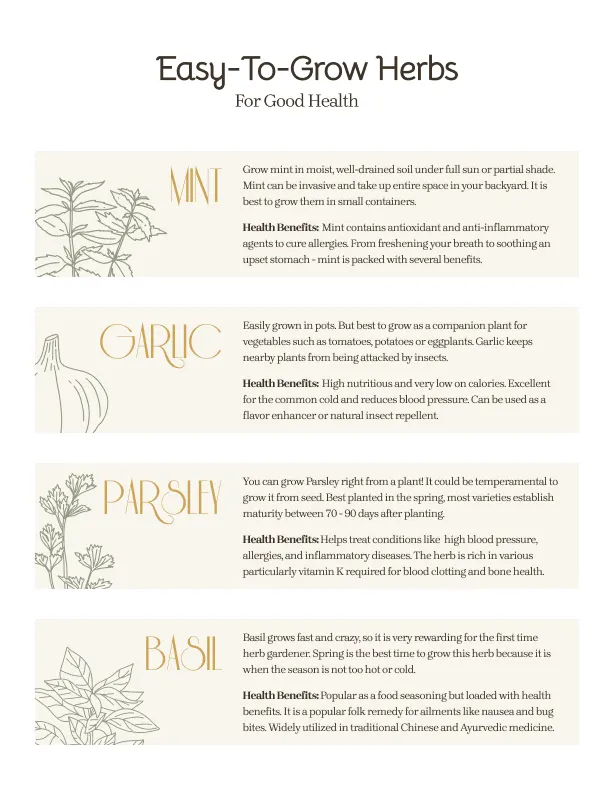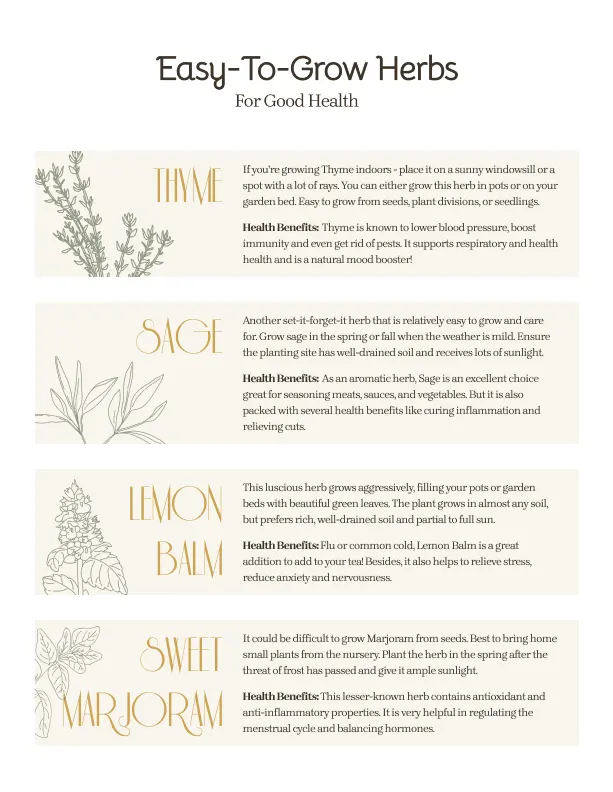December 12, 2022
Herbs for Good Health: A Beginner’s Guide
We’ve compiled a list of easy-to-grow herbs you can pot in your backyard, on the patio or even on your windowsill. These herbs are loaded with huge health benefits and you’ll want to include them in your daily cooking. But how do you care for and grow them? What are those herbs that you might want to consider growing? What unique benefits do they offer? To answer all your questions, download FTD Canada’s free fridge chart for beginners. It is a quick, visual guide on herbs for good health.
Easy-to-grow Herbs for Good Health
Mint
Grow mint in moist, well-drained soil under full sun or partial shade. Mint can be invasive and take up entire space in your backyard. It is best to grow them in small containers.
Health Benefits:
Mint contains antioxidant and anti-inflammatory agents to cure allergies. From freshening your breath to soothing an upset stomach – mint is packed with several benefits.
Garlic
Easily grown in pots. But best to grow as a companion plant for vegetables such as tomatoes, potatoes or eggplants. Garlic keeps nearby plants from being attacked by insects.
Health Benefits:
High nutritious and very low on calories. Excellent for the common cold and reduces blood pressure. Can be used as a flavor enhancer or natural insect repellent.
Parsley
You can grow Parsley right from a plant! It could be temperamental to grow it from seed. Best planted in the spring, most varieties establish maturity between 70 – 90 days after planting.
Health Benefits:
Helps treat conditions like high blood pressure, allergies, and inflammatory diseases. The herb is rich in various particularly vitamin K required for blood clotting and bone health.
Basil
Basil grows fast and crazy, so it is very rewarding for the first time herb gardener. Spring is the best time to grow this herb because it is when the season is not too hot or cold.
Health Benefits: Popular as a food seasoning but loaded with health benefits. It is a popular folk remedy for ailments like nausea and bug bites. Widely utilized in traditional Chinese and Ayurvedic medicine.
Thyme
If you’re growing Thyme indoors – place it on a sunny windowsill or a spot with a lot of rays. You can either grow this herb in pots or on your garden bed. Easy to grow from seeds, plant divisions, or seedlings.
Health Benefits: Thyme is known to lower blood pressure, boost immunity and even get rid of pests. It supports respiratory and health health and is a natural mood booster!
Sage
Another set-it-forget-it herb that is relatively easy to grow and care for. Grow sage in the spring or fall when the weather is mild. Ensure the planting site has well-drained soil and receives lots of sunlight.
Health Benefits: As an aromatic herb, Sage is an excellent choice great for seasoning meats, sauces, and vegetables. But it is also packed with several health benefits like curing inflammation and relieving cuts.
Lemon Balm
If you’re growing Thyme indoors – place it on a sunny windowsill or a spot with a lot of rays. You can either grow this herb in pots or on your garden bed. Easy to grow from seeds, plant divisions, or seedlings.
Health Benefits: Thyme is known to lower blood pressure, boost immunity and even get rid of pests. It supports respiratory and health health and is a natural mood booster!
Sweet Marjorm
It could be difficult to grow Marjoram from seeds. Best to bring home small plants from the nursery. Plant the herb in the spring after the threat of frost has passed and give it ample sunlight.
Health Benefits: This lesser-known herb contains antioxidant and anti-inflammatory properties. It is very helpful in regulating the menstrual cycle and balancing hormones.
Rosemary
It’s easy to grow rosemary indoors by the window sill. The shrub has a moderate growth rate but spreads when planted. Space the shrubs at least 2-3 feet apart and barely cover the seeds with soil while planting.
Health Benefits: Rosemary is a natural mood booster besides boosting alertness. Besides, it helps stimulate hair growth, relieve indigestion, and promote metabolic health.
Peppermint
Peppermint is a hybrid mint, a cross between water mint and spearmint. prefers rich soil and partial shade. Like other mints, it spreads quickly, so consider planting it in containers.
Health Benefits: Peppermint can be used for flavoring but is also useful as a natural pesticide. The herb also reduces the effects of irritable bowel syndrome.
Coriander
Cilantro (Coriander leaf or Chinese parsley) prefers warm soil. If you’re growing the herb in a container, make sure it is at least 8 inches deep. Water the plants often, and feed them with a nitrogen fertilizer once they hit 2 inches in height.
Health Benefits: Cilantro is a perfect go-to in Mexican, Chinese, Southeast Asian and Indian cuisines. But the herb helps to protect brain health, promote digestion and gut health and is rich in immune-boosting antioxidants.
Chamomile
You can grow German or Roman chamomile, since the two varieties are interchangeable when it comes to making tea. German chamomile is an annual plant and grows up to 3 feet tall. Roman chamomile is a perennial variation and only grows to about a foot high.
Health Benefits: In traditional medicine, Chamomile is used in stomach problems and calming the nerves. It also helps reduce inflammation and treat fevers.




